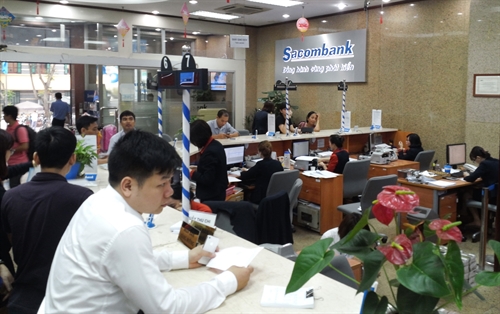 Economy
Economy

Pressure from ensuring liquidity, meeting rising credit demands and purchasing Government bonds has caused commercial banks to hike their savings interest rates to attract depositors.
 |
| Customers deposit money at Sacombank’s branch in Hà Nội. Sacombank offers the highest deposit rate of 7.55 per cent for 13-month deposit of at least US$22 million. — VNS Photo Đoàn Tùng |
HÀ NỘI – Pressure from ensuring liquidity, meeting rising credit demands and purchasing Government bonds has caused commercial banks to hike their savings interest rates to attract depositors.
Instead of introducing promotional programmes, as in the past, banks have used their high deposit rates to lure customers. Currently, the central bank sets a cap of 5.5 per cent on short-term deposits of less than 6 months. Meanwhile, higher rates are floated.
Viet Capital Commercial Joint Stock Bank (Viet Capital Bank), for example, has launched a programme in which online deposit interest rates have been increased by 0.3 per cent per year since April.
Also, Viet A Commercial Joint Stock Bank (VietA Bank) offers an additional 0.2 per cent interest rate per year for depositors aged 45 years and older.
Other banks also add 0.2 to 0.3 per cent interest rate per year to customers depositing large amounts of money.
The Export Import Commercial Joint Stock Bank (Eximbank), Sacombank and Orient Commercial Joint Stock Bank (OCB) are offering the highest deposit rates of 7.5 per cent, 7.55 per cent and 7.7 per cent per year, respectively, for 13 month deposits of at least VNĐ500 billion (US$22.2 million).
A report from the National Financial Supervisory Committee also showed that liquidity at banks last month was under pressure, pushing inter-bank rates up 1 per cent for all terms.
Experts attributed the interest hike in deposits to rising credit demands and the draft revised Circular 36/2014/TT-NHNN, which lowers the ratio of using short-term funds for medium and long-term rates from 60 to 40 per cent. Currently, the ratio at State-owned banks is 33.91 per cent, while the rate is higher at 35.58 per cent at commercial joint stock banks. Therefore, these banks have the need to attract long-term mobilisation to ensure they reach their prescribed limits.
Additionally, banking expert Nguyễn Trí Hiếu said that banks are being forced to hike deposit interest rates to ensure liquidity, besides meeting rising credit demands.
Further, according to experts, banks also need capital to purchase Government bonds. This year, the finance ministry plans to issue G-bonds worth VNĐ220 trillion, of which nearly VNĐ111.79 trillion in G-bonds were issued by May 6. In Viet Nam, banks are allocated more than 80 per cent of total G-bond purchases.
Banks also need capital to boost consumer lending, as these loans have higher interest rates than corporate loans.
As for VP Bank, for example, after reporting a profit of nearly VNĐ1 trillion from consumer loans last year, the bank targeted its consumer loans to rise by more than 30 per cent this year.
Phạm Hồng Hải, general director of HSBC Vietnam, told baodautu.vn that deposit interest rates are likely to inch up in the near future due to increasing credit demands, as well as the Ministry of Finance needing to issue a large volume of G-bonds, and to comply with the draft of Circular 36/2014/TT-NHNN.
Unlike deposit rates, lending rates in dong at banks have largely remained steady in recent years. According to Hải, lending rates are likely to rise slightly in the near future because banks need to maintain a reasonable profit margin when input costs have increased. However, medium- and long-term lending rates will be reduced for businesses with good credit.
According to financial expert Huỳnh Trung Minh, lending rates will only increase slightly, compared to current levels, unless there are strong impacts from external factors, especially exchange rates if the US Federal Reserve increases US dollar interest rates. The reason is that if lending rates increase, it will be difficult to increase the demand for credit.
According to banking expert Huỳnh Bửu Sơn, lending rates available to applicable enterprises are currently ranging from 8 to 9 per cent per year on short term loans, and higher on medium and long term loans, while the demands for credit among enterprises manufacturing export products are mainly short term. However, if lending rates are raised, enterprises will reconsider their business and investment plans. - VNS









